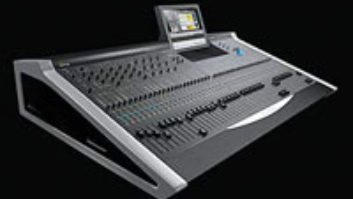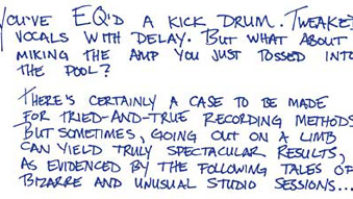It’s autumn. A change of season is upon us, with the twilight of summer and the smell of frying power supplies in the air. It may also be the twilight for the SCSI standard, having just celebrated its 20th anniversary with a wee shindig down in San Jose, Calif. SCSI better watch out as the young Turks emerge to usurp its crown.
You may think I’m bonkers, but the SCSI Trade Association really did have a birthday party for the standard that has soldiered on longer than any of its architects had imagined. For performance storage peripherals, it’s still the attach method of choice, with the installed base dwarfing Fibre-Channel, its only competition. For high performance in a multi-user environment like sound-for-picture, Fibre-Channel is the way to go. Granted, most SANs continue to use SCSI-attached drives behind a FC facade.
Native FC devices are working their way into the marketplace. However, they’ll never achieve the level of penetration that SCSI has enjoyed, simply because there just are few installations requiring the high performance and availability afforded by Fibre-Channel. Desktop hardware will continue to dominate the number of storage devices shipped for quite some time, but the emerging trend that will both affect pro users and turn the storage industry on its head is home servers.
Perhaps I should be more general and refer to “home servers” as storage for information appliances. But whatever terminology you prefer, the reality is that DTV, P2P, DVD2, FTTH (Fiber To The Home) and other technologies will soon converge on Jane C. Consumer. Note: The “C” stands for Conspicuous, requiring the purchase of the latest and greatest gadget. This home electronics trifle will most certainly contain rotating storage — at least until some serious manufacturing hurdles are overcome — and the cheapest rotating storage is still magnetic. Home servers, STBs (SetTop Boxes) and personal video recorders all require big storage, but it’s got to be cheap, and SCSI ain’t cheap. Now, ATA — that’s “cheap,” but most marketing types prefer the term “cost effective.”
Intel has made a lot of noise in the hope of establishing USB, its Universal Serial Bus spec (or “Unused Serial Bus” to its detractors) as the de facto standard for external peripheral attachment. Unfortunately, those in the know tend to dismiss USB as a great way to hook up brain-dead devices, but nothing that requires serious negotiations with either host or peer. SATA or Serial ATA is another matter. Unlike USB, SATA is designed for inside the box, not outside where Jane C. can muck about with it. Along with InfiniBand, another fundamentally radical internal technology, SATA will change the look, feel and performance of new computers.
Wicked competition in both the consumer appliance and desktop computing space dictates that manufacturing cost be trimmed to the bone. Intel has proposed SATA as the nex-gen storage attach protocol that promises to finally give SCSI stiff competition for manufacturers’ dollars. Here’s the spin on SATA from Intel’s Developer Forum: “This technology will enable smaller, sleeker PC designs by replacing today’s bulky ribbons with very thin cables that can quickly transfer large amounts of information. The cables and connectors will replace today’s products based on the Parallel ATA storage interface. Serial ATA will enable future growth and stability of computers, while maintaining compatibility with today’s software base.”
Along with Intel, the specification working group includes IBM, Dell, Maxtor/Quantum, Seagate and APT Technologies, an engineering company. Version 1.0 of the spec, dubbed Ultra SATA/1500, was released in November 2000. So, what, you ask, is so cool about SATA? Well, Bucko, it’s that “S,” as in “Serial.” Take a parallel communications bus over a fat ribbon of conductors and serialize it by time-domain multiplexing. This converts that wide ribbon hooked in a finicky physical serial configuration to just a single conductor, plus shield capable of star configurations. That, in itself, is nothing too rad, but it does allow computer manufacturers to reduce the total internal volume while boosting the data throughput to 1.5 Gbps to start. Double and quad-speed versions are scheduled to follow the roll-out of the first Ultra SATA/1500 products next year.
To me, Serial ATA means Slim, Attractive Technology Advancement. To you, it’ll just be a good thing.
OMas looks forward to The Pueblo by the Bay’s one month of summer. Long live warm weather! This column was created while under the influence of Love Tractors’ (they’re baaaack) theskyatnight and Joe Satriani’s Engines of Creation. For links and occasional commentary, visithttp://seneschal.net.
PEDANT IN A BOX
THIS MONTH’S BUZZWORDS
ATA (Advanced Technology Attachment): ATA is the name given to the specification covering IDE (Integrated Drive Electronics) by ANSI, the American National Standards Institute. IDE is an attachment interface used between motherboard and disk. IDE is, in turn, based on the IBM PC’s Industry Standard Architecture (ISA), a 16-bit bus standard. EIDE, an enhanced version of IDE, includes — along with support for DMA (Direct Memory Access) and nondisk devices like CD and tape — a 28-bit Logical Block Address (LBA) to specify the actual cylinder, head and sector location of data on the disk. The 28 bits provide an address space of up to 8.4 GB in size, hence the 9GB ATA drives typically seen in most mass-market computers.
TDM: Despite what Digidesign’s marketing department would like you to think, Time Domain Multiplexing is a 1-channel coding method for delivery of multibit data over a serial transmission channel. ADAT Lightpipe and the AES Type II S/PDIF optical interfaces are two common examples of inherently parallel data (AES/EBU linear PCM) being channel-coded or repackaged for serial transmission over a single, consumer-grade Plastic Optical Fiber (POF).






